-- China's trade with the ASEAN stood at 2.51 trillion yuan (about 362 billion U.S. dollars) in the first seven months, up 6.6 percent year on year.
-- The expansion in China-ASEAN trade has been partly buoyed by the implementation of an upgraded China-ASEAN Free Trade Area (CAFTA) protocol since October 2019.
-- As ASEAN nations eyed recovering their economies hit by the pandemic, Chinese e-commerce giants such as Alibaba and JD.com have provided the businesses with access to one of the world's largest markets.
-- Besides traditional trade, China and ASEAN countries are also conducting high-tech industry cooperation.
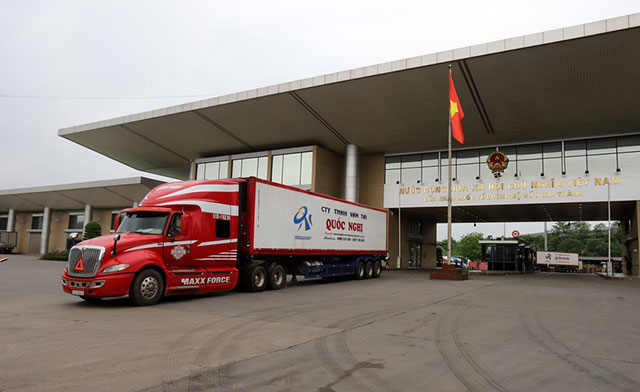
Photo taken on May 27, 2020 shows a container truck carrying Vietnamese lychees exported to China at Kim Thanh II International Border Gate in Vietnam's northern Lao Cai province, which borders China. (VNA via Xinhua)
by Xinhua writers Chen Jian, Huang Shuo, Lin Hao
HONG KONG, Aug. 27 (Xinhua) -- "I want more Chinese traders to come here to buy and export our fresh, sweet and succulent dragon fruits," Nguyen Huy Phong, a 50-year-old farmer from Vietnam's southern Binh Thuan province, told Xinhua on Wednesday.
In the first half of the year, China's trade with Vietnam jumped 18.1 percent, pushing bilateral trade to the top slot among members of the Association of Southeast Asian Nations (ASEAN), data from China's General Administration of Customs showed.
In addition, China's trade with the ASEAN stood at 2.51 trillion yuan (about 362 billion U.S. dollars) in the first seven months, up 6.6 percent year on year.
The ASEAN remained China's biggest trading partner during the same period, accounting for 14.6 percent of its total foreign trade volume.
While the COVID-19 pandemic has caused a disruption in the global supply chain, China-ASEAN trade relations "are being further boosted by great efforts from two sides, including governments who are determined to find measures to maintain trade flow and eliminate COVID-19's impacts, and the businesses themselves who are committed to the potential markets," said Vo Tri Thanh, former deputy head of Vietnam's Central Institute for Economic Management.
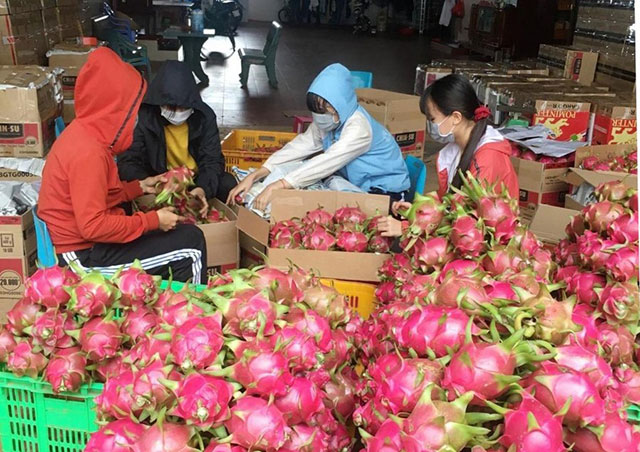
People package dragon fruits in the city of Buon Ma Thuot in Vietnam's central highlands Dak Lak province on Aug. 12, 2020.(VNA via Xinhua)
FREE TRADE
"Multilateral trade is still an irresistible trend," said Azlimi Zakaria, consul general of the Consulate General of Malaysia in Nanning, the capital of China's southwestern Guangxi Zhuang Autonomous Region, adding that the increasingly close economic and trade relations between ASEAN countries and China remain vigorous through multilateralism and free trade.
The expansion in China-ASEAN trade has been partly buoyed by the implementation of an upgraded China-ASEAN Free Trade Area (CAFTA) protocol since October 2019, which has further facilitated agricultural trade and brought dividends to CAFTA members.
"The revised deal covering 11 countries with a population of around 2 billion people helps to simplify many procedures, including rules of origin, currency, services, and investment," Thanh said.
Founded in 1967, ASEAN now groups Brunei, Cambodia, Indonesia, Laos, Malaysia, Myanmar, the Philippines, Singapore, Thailand and Vietnam.
John Tan, a coconut exporter based in Davao in the southern Philippines, told Xinhua that he received orders for tropical fruits from China as usual despite the COVID-19 outbreak.
"I'm not short of orders, but I'm short of hands," said Tan, president of Eng Seng Food Products, adding that he did not have enough workers due to COVID-19 lockdown measures.
"Even under these circumstances, we are still managing to send about five to six containers of young coconuts to China every week," he added.
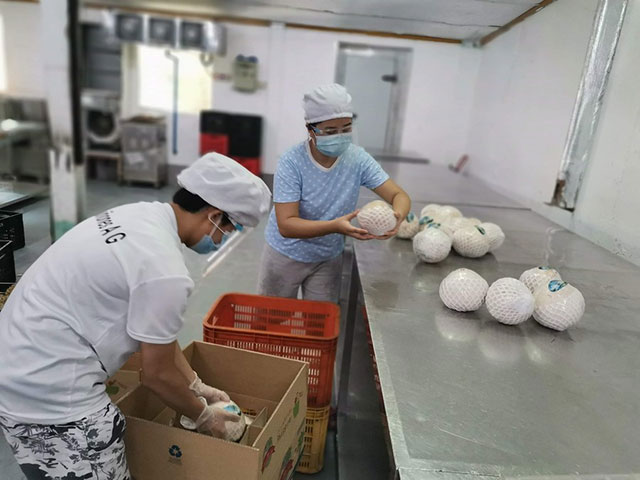
Workers box processed coconuts in Davao, southern Philippines, Aug. 26, 2020. (Xinhua)
During the virtual Regional Comprehensive Economic Partnership (RCEP) ministerial meeting on Thursday, ministers of ASEAN members, China, Japan, South Korea, Australia and New Zealand reaffirmed their commitment to signing the deal at its upcoming November summit.
Initiated by ASEAN in 2012, RCEP is a proposed FTA between the 10 ASEAN member states and their six partners -- China, Japan, South Korea, Australia, New Zealand and India. In November, 15 participating countries of the agreement concluded text-based negotiations and essentially all market access issues at an RCEP summit in Thai capital Bangkok.
Federation of Malaysian Manufacturers president Soh Thian Lai said it was important for ASEAN nations, such as Malaysia, to commit itself to the agreement in the interest of future economic development, especially in facing the economic aftermath caused by COVID-19.
"I believe the signing of such a mega FTA like RCEP will greatly contribute to the region's post-pandemic recovery and in creating resilient supply chains," he told Xinhua.
Cambodian Commerce Ministry Secretary of State and Spokesman Seang Thay said the RCEP will provide the participating countries with greater market access, and through it, relations in economy, trade and investment between the ASEAN and their partners will be further broadened.
"Once signed, the RCEP will be the world's largest FTA by population. All countries will benefit from it," he said.
The RCEP accounts for 45 percent of the world population, 40 percent of global trade and around one third of the world's gross domestic product (GDP).
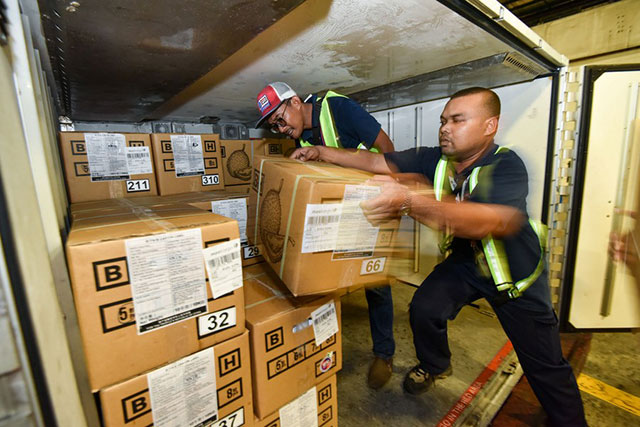
Boxes of durians to be exported to China are put into a refrigerated container at the Kuala Lumpur International Airport in Malaysia, June 18, 2019. (Photo by Chong Voon Chung/Xinhua)
DIGITAL COOPERATION
This year is designated as the China-ASEAN Year of Digital Economy Cooperation, and the pandemic has further highlighted the importance of digital economy in economic recovery, job creation and improvement of livelihood.
On Aug. 18, China's Guangxi and the ASEAN agreed to build the China-ASEAN Digital Trade Center to boost digital economy cooperation.
Headquartered in Nanning, the center is designated as a digital economy development park, with facilities for digital creative industries, platform operations, big data, and the internet of things, among others.
As ASEAN nations eyed recovering their economies hit by the pandemic, Chinese e-commerce giants such as Alibaba and JD.com have provided the businesses with access to one of the world's largest markets.
On June 9, Thai Deputy Prime Minister and Commerce Minister Jurin Laksanawisit helped sell nearly 5,000 durians and 20,000 coconuts to Chinese consumers via a live-streaming sale on Alibaba's Tmall.

A worker cleans a durian at a durian processing factory in Pahang, Malaysia, June 18, 2019. (Xinhua/Zhu Wei)
With China's appetite for the pungent "king of fruits" undiminished by the pandemic, the Thai Commerce Ministry said durian sales to China have secured 1.02 billion dollars in the first half of this year, up 140 percent year-on-year.
Since June last year, Malaysia, also a major durian producer in Southeast Asia, started exporting durian to China as frozen whole fruits, many through e-commerce platforms. The Chinese market remains a great support for Malaysian farmers during the time of economic recovery.
Lu Yee Thing, a durian farm owner in Malaysia's central Pahang state, told Xinhua that durian shipments to China have increased to 50 percent of the farm's total exports.
"Many Chinese consumers order our durians directly online," he said, adding "I'm very confident in future business, and I will expand planting areas to meet the demand of the Chinese market."
For ASEAN, the digital economy is expected to increase from 1.3 percent of GDP in 2015 to 8.5 percent by 2025, according to ASEAN Secretary-General Lim Jock Hoi.
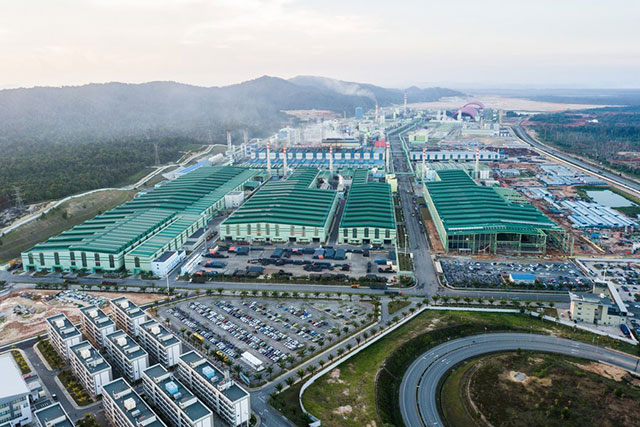
Aerial photo taken on April 15, 2019 shows the Alliance Steel at the Malaysia-China Kuantan Industrial Park in Pahang, Malaysia. (Xinhua/Zhu Wei)
HIGH-TECH INDUSTRY, INVESTMENT
Besides traditional trade, China and ASEAN countries are also conducting high-tech industry cooperation.
The China-ASEAN Information Harbor Co. Ltd., a Nanning-based info-tech company, has been dedicated to China-ASEAN digital and information industrial collaboration over the past few years.
Three international communication submarine cables, 12 international terrestrial optical cables, and 13 key communications nodes have been built to link China and ASEAN nations, the company said.
Moreover, China and ASEAN countries have cooperated in satellite navigation before China's BeiDou Navigation Satellite System was commissioned on July 31.
China has begun to provide navigation services to some ASEAN countries, and will promote the socio-economic development of ASEAN nations, especially in the fields of modern agriculture, digitization and intelligent ports, said Ran Chengqi, director of the China Satellite Navigation Office.
Relying on each other's advantages, governments and enterprises from China and ASEAN nations have promoted and realized mutual investment.
The Malaysia-China Kuantan Industrial Park (MCKIP) in Malaysia's Pahang state has been jointly developed by the two countries as a major project under the China-proposed Belt and Road Initiative.
The MCKIP and the China-Malaysia Qinzhou Industrial Park, collectively called the Twin Parks, have been identified by the Malaysian and Chinese governments as iconic projects in their bilateral investment.
According to the Chinese Ministry of Commerce, the accumulated two-way investment between the ASEAN and China reached 236.91 billion dollars in 2019. ■
(Xinhua reporters Tao Jun in Hanoi, Mao Pengfei in Phnom Penh, Yang Ke, Yuan Mengchen in Manila, Wang Jin in Bangkok, Pan Qiang and Huang Yaoteng in Nanning also contributed to the story.)
(Video reporters: Xia Peng, Lin Hao, Huang Yaoteng, Chen Jian, Huang Shuo, Tao Jun, Mao Pengfei, Yang Ke, Yuan Mengchen, Wang Jin, Pan Qiang; Video editor: Zhou Sa'ang)

- Booming fruit trade highlights China-ASEAN cooperation
- Region’s diplomats praise ties with key trade partner
- Hainan Free Trade Port RCEP Business Service Center unveiled
- Land-sea trade corridor facilitates exchanges between China, ASEAN countries
- Land-sea trade corridor witness growth
- China’s services trade opening-up creates opportunities for world
Popular Videos
Hot comments
- First apes at U.S. zoo receive COVID-19 vaccine made for animals, zoo official says
- China Life: Chinese women shine with She Power
- Foreign firms approved to offer VPN services in capital
- Homemade curling videos trending in China
- 86-year-old grandma in Hebei spends most her life on traditional cheongsam
- Winners of 2022 Inaugural WLA Prize announced
- Lantern Festival: A romantic celebration in China
- Two Chinese COVID-19 vaccine firms to supply vaccines to COVAX
- Media center for 20th CPC national congress to open on Oct. 12
- Six suspects arrested in HK for role in SE Asia job scam
Top Reviews
- Young artists recreate beauty of traditional Hanfu costume
- China releases photos of tallest tree
- English version of ‘Understanding Xi Jinping’s Educational Philosophy’ published
- China crowned in men’s team for 10th straight time at table tennis worlds
- China publishes Atlas of Wildlife in SW China
- Guangxi’s 10 Years: A Visit to China’s Qinzhou Port
- Congress delegate helped lift village out of poverty
- Expo highlights joint efforts in NEV development
- Racism stain of shame on ‘world democratic paradise’
- U.S. may face new COVID wave this upcoming winter: report







